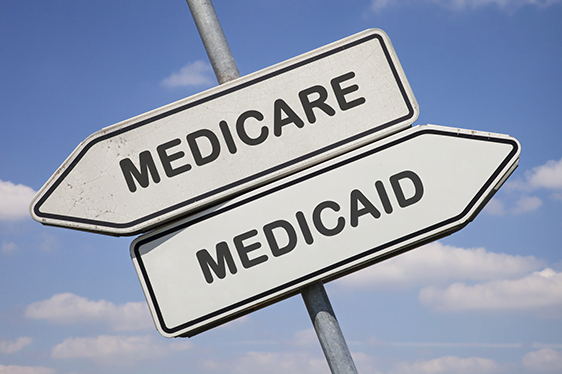Filter


More People with Disabilities Have Medicaid
The Affordable Care Act has helped significant numbers of people with disabilities pay for the medical care their serious conditions require by adding Medicaid as a second layer of insurance to their standard Medicare coverage. Dual eligibility for Medicare and Medicaid increased from 38 percent of people receiving disability benefits to between 42 percent and 44 percent in the 14 states that accepted the federal option to expand their Medicaid programs immediately after legislation started subsidizing these expansions in 2014, according to RAND researchers. Medicare isn’t just for retirees, and the researchers were curious about how broader Medicaid coverage has affected people under 65 who receive Social Security’s disability insurance. They automatically go on Medicare two years after becoming eligib…
May 2, 2023
Women Have Lost a Little Ground on Pay Equality
The earnings gap between women and men remains stubbornly large. So even a little progress counts as good news. One group of women made some gains during the pandemic. Let’s use the term middle class as shorthand for someone earning between 40 percent and 60 percent of all workers’ wages. The Economic Policy Institute (EPI) said in its wage report that these women made “a small but promising move in the right direction.” In 2019, middle class women earned 83.8 cents for every dollar that middle-class men earned. In 2022, the women’s pay rose to 84.6 cents. Here’s the bad news. The pay gap for all female workers widened. They earned 79.7 cents for every dollar a man was paid…
April 27, 2023
Economics of Race: a Top Research Priority
Numerous articles have appeared here in recent months about the ways that racial disparities are infused into our financial and economic systems. Two barriers to Latinx and Black workers’ ability to save, for example, are less health insurance coverage and more burdensome student loan payments than White workers have. Or consider the different long-term housing options available to Black and White seniors. And while COVID’s financial toll hit people with disabilities especially hard, it was even tougher for people of color with disabilities. The theme of the research studies featured in these and other articles is no accident. The studies are funded by the U.S. Social Security Administration (SSA), which encourages researchers around the country to explore the socioeconomic aspects…
April 25, 2023
The Down Payment Dilemma for Blacks and Hispanics
I am neither Black nor Hispanic but can relate in one small way to the difficulty so many people of color have coming up with a down payment for a house. Years ago, as a single person, I didn’t have the cash for a down payment either. But I was able to borrow $10,000 from my 401(k) to buy a small condominium in Somerville, Mass., next door to Boston. And I was fortunate to have a generous friend who made an unsolicited $10,000 donation to the cause. Sometimes, parents come to the rescue and help their adult children get over the down payment hurdle. Harvard University’s Joint Center for Housing Studies quantifies the financial dilemma for Black and Hispanic workers,…
April 20, 2023
COVID Tested Resilience of Older Americans
Resilience – financial, emotional, and in the form of family and community support – was sorely tested when COVID-19 turned lives upside down. In a study of workers and retirees 50 and older, the people who lived alone or with extended family struggled the most in the first year of COVID to make the financial adjustments required to get through the economic slump. And due to their age, they had the added challenge of dealing with chronic health conditions or physical impairments when medical and personal services were out of reach. Researchers at Harvard’s Joint Center for Housing Studies used a variety of ways to gauge their resilience and identify where that resilience broke down in 2020. The study describes…
April 18, 2023
Work’s Getting Easier for Most Older Workers
Technology has had a profound impact on how we work. Changes in what employers expect from an aging workforce reflect that evolution – and the changes have largely been positive. Americans in their late 50s and early 60s increasingly are holding jobs that require them to be highly trained or college educated to take on the cognitive tasks the positions require. Occupations such as sales, production, laborer, and repair have given way to technical and professional employment, according to the Urban Institute’s in-depth analysis of U.S. occupational data. But while the mix of jobs in the economy has clearly changed, the more significant change underway has occurred within specific occupations, the researchers said. Older workers find that all kinds of…
April 13, 2023
Negotiating the Medigap-Advantage Maze
Choosing a Medicare option is one of the biggest decisions baby boomers make. Nearly half of U.S. retirees today have Medicare Advantage policies – that’s double the market share just 15 years ago. The reason for Advantage plans’ popularity is their low monthly premiums. But as enrollment surges, some of our blog readers who signed up for the plans have complaints. Advantage plans are complete insurance policies that operate much like employer health plans with copayments and deductibles. They have been heavily criticized for becoming increasingly profitable and costly for the federal Medicare program, which reimburses insurers for retirees’ care. And retirees complain that they can’t go to any doctor or hospital they like. They are talking about Advantage plans…
April 11, 2023
A Personality Trait Tied to Stock Investing
Researchers have tried and failed to fully understand why so many people are unwilling to plunge into the stock market and ride the ups and downs of an investment that pays off over the long haul. A new study finally lands on something that has the power to affect how people invest: personality. In fact, personality is as good at explaining investment decisions as the sex, age, income, wealth, and education of individuals combined, said researchers at Northwestern, DePaul University, and the London School of Economics. They examined the Big 5 personality traits: openness, conscientiousness, extraversion, agreeableness, and neuroticism. Openness and neuroticism have the most influence on stock investing – with opposite effects. On the other hand, agreeableness, characterized by…
April 6, 2023
Employers Will Pay More to Avoid Flextime
Workers love flexible schedules. Employers, it seems, do not share their warm feelings. Employers said they’d be willing to pay substantially more – 20 percent to 60 percent more – to a worker who is willing to accept only a limited amount of scheduling flexibility or a rigid schedule, according to the preliminary findings of a new RAND study. This research is fairly unusual, because most of the studies of working arrangements have looked at employees’ preferences. And they show a clear preference for setting their own schedules or avoiding last-minute scheduling, an unpopular practice many retailers have adopted. In this study, David Powell and Jeffrey Wenger at RAND conducted an experiment to look at the flip side of t…
April 4, 2023
Mortgage Rejections Surge after Age 50
You’re over 50. You have built up a lot of equity in your home, and your life savings is finally gaining some critical mass. And yet, your odds of being rejected for a refinancing mortgage start going up rapidly after age 50 and really accelerate around 70, according to a study by Natee Amornsiripanitch at the Federal Reserve Bank of Philadelphia. This evidence, concludes a recent summary of the study, “is large and robust.” The research has important implications for older workers trying to prepare financially for retirement or retirees planning to change their living arrangements. Higher rejection rates can throw a wrench into refinancing an existing mortgage, cashing out some home equity, and possibly downsizing to a less expensive home. Yes, rejecting borrowers…
March 30, 2023
Older US Workers of Color at a Disadvantage
As workers age, poor health or disabling physical conditions can interfere with holding down a job. Sometimes people are forced to quit working if things get really rough, whether they’re ready to retire or not. But race also figures into this predicament, because workers of color are already in poorer health and tend to have more vulnerable employment situations than White workers. A new study compares what’s it’s like to be an older Black, Hispanic or Asian person who is trying to keep working in two countries with similar cultures: the United States and England. The United States does not come out on top. The building blocks for this research are basic comparisons of White and minority workers’ health and…
March 28, 2023
Remote Work Didn’t Recede with Pandemic
The remote work necessitated by COVID may be here to stay in five English-speaking countries from Australia to the United States. That’s the conclusion from a study of 250 million online job ads – nearly half of them in this country. The number of postings in January that offered remote work for one or more days per week was three to five times larger than the remote work positions advertised on the cusp of the pandemic in 2019. Notably, their numbers increased sharply last year as COVID was retreating. The countries in the study are: Australia, Canada, New Zealand, the United Kingdom, and the United States. The United Kingdom has the largest share of positions advertising remote work – 18 percent. T…















